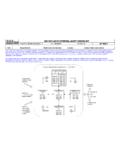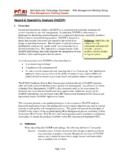Transcription of QPP-061-1 Risks and Opportunities (full text)
1 This procedure addresses ISO 9001:2015 clauses Actions to address Risks PROCESSP urpose: The purpose of this procedure is to provide for a system and instructions, and toassign responsibilities for identifying and evaluating Risks and Opportunities . Application: This procedure applies to Risks related to processes, quality, suppliers andbusiness practices; and to Opportunities arising from actions to control these this procedure the application of risk management is limited to Risks that are relevant toquality and the quality management system.
2 However, where appropriate, the scope couldbe extended to also include Products and/or Services ( Risks to users, customers,environment, etc.); Health and Safety ( Risks to the health and safety of workers);Environment ( Risks of uncontrolled emissions, spills, etc.); and any other types of Risks thatneed to be identified and owners:<Quality>II PROCESS ACTIVITIES AND PROCEDURE1 Risk The need for risk identification is determined on the basis of information and trendsregarding the performance and effectiveness of the quality management system. In particular:Edit this list as appropriate.
3 For example, if you don t perform servicing, delete anyreferences to service records. Reject and scrap rates Product and service nonconformities Process problems and nonconformities Supplier quality performance records Field service records On time delivery performance Production equipment maintenance records Customer feedback and complaints Quality management system audit records Data loss/corruption incidents, network outages, Risks are identified and evaluated when quality performance data indicates that there aretrends of decreasing quality capability and/or effectiveness of the quality managementsystem.
4 For example: increasing incidence of product nonconformity; excessive equipmentproblems; or increasing number of audit findings against the same quality system process ordepartment. QPP-061-1 Risks and Opportunities (full text) Issued by: Quality Assurance Status: Draft Rev. B Pg. 1 of 5 2 OpportunitiesThe concept of an 'Opportunity' is tied in ISO 9001:2015 to Risk, but the standard fails toadequately explain the relationship between the two. The only 'official' explanation is givenin a paper published by ISO titled 'Risk-based thinking in ISO 9001:2015'.
5 In this paper, theopportunity is defined mostly as a 'positive effect of risk' -- a silver lining of having tomitigate or counteract Risks . It makes a good sense philosophically, but doesn't offer a cluehow to actually comply with the ' Opportunities ' requirements in ISO 9001:2015. Shouldopportunities be identified independently and then analyzed for their own Risks ? Or, shouldrisk reduction measures be identified as Opportunities ? Or both? An opportunity is a set of circumstances which makes it possible to do positive things, forexample: Develop new products and services Develop new markets and/or increase market share Improve work environment Improve productivity Improve operational efficiency (reduction of resource use, reduction of waste, etc.)
6 Opportunities may be identified as positive effects of Risks ; as in a risk forcingimplementation of a risk reduction measure that is beneficial in a broader context than justreducing this particular risk. For example, health Risks may require measures to improveworking environment. However, these measure also create Opportunities to attract betterqualified employees, improve morale and job satisfaction, and reduce turnover; and so thehealth risk creates Opportunities to improve the overall job Taking or not taking an opportunity presents different levels of risk.
7 To evaluate these Risks ,taking (or not taking) the opportunity is defined as a risk management project, and theassociated Risks are evaluated as for any other project, , following this Initiating risk management Risks are identified, evaluated and addressed in IMSX press > Risk Management module;within a framework of a Risk Management Risk management projects may be proposed by any organizational unit and any employee inthe company. Requests for initiating a risk management project are submitted to <Quality>.Only<Quality> has the authority to initiate, or approve the initiation of risk managementprojects.
8 This is to prioritize and direct resources where risk control is most Risk management Risk management projects are initiated inIMSX press > Risk Management module usingelectronic form EF-380-1 Risk When initiating a new project, select in formEF-380-1 the risk assessment method that willbe used for the project: Hazard Evaluation: This is a method for evaluating hazards and related harms, ratherthan estimating the actual Risks . The method is based on evaluating hazardous situations QPP-061-1 Risks and Opportunities (full text) Rev. B Pg.
9 2 of 5 and associated harms (risk cases), and existing controls that reduce the likelihood of thehazardous situation occurring and/or reduce the severity of the harm. The evaluationresults in a decision whether additional controls need to be implemented to further reducerisk. Although no a full fledged risk analysis, it is an excellent method for demonstrating'risk based thinking' without going into formal and complex risk analysis studies. Similarmethods are widely used for identifying and controlling health and safety related Risks . Risk Matrix Analysis: This is a structured, formal method for assessing Risks using a riskmatrix.
10 The risk matrix for the project is defined using a template provided in formEF-380-01 (click the Risk Matrix tab in the form). This method is often referred to intechnical literature as a Preliminary Hazard Analysis (PHA). It is a top-down approach,using a list of known hazards as input for the risk analysis. The risk matrix method is themost flexible and versatile, as it can be applied to any product, process or system, anddoes not require detailed knowledge about the system to be analyzed. Other Method: Select this item when some other risk assessment method will be used,for example: Failure Mode Effects Analysis (FMEA), Failure Mode, Effects andCriticality Analysis (FMECA), Fault Tree Analysis (FTA), Hazard Analysis and CriticalControl Points (HACCP), hazard operability Analysis ( hazop ), Risk management projects are periodically reviewed to ensure that they remain relevant andup to date.



